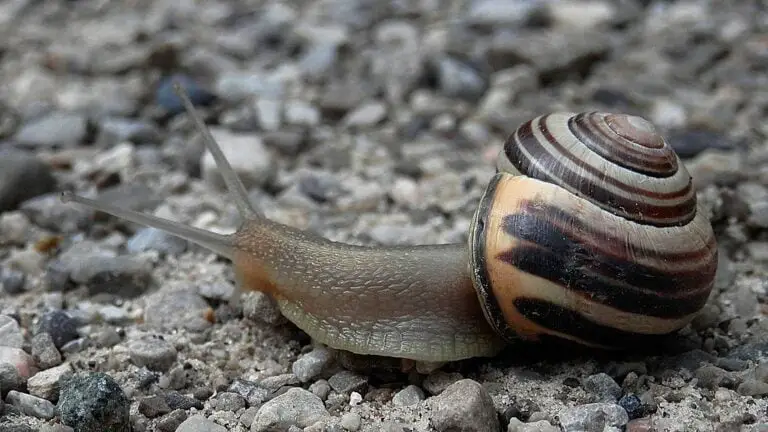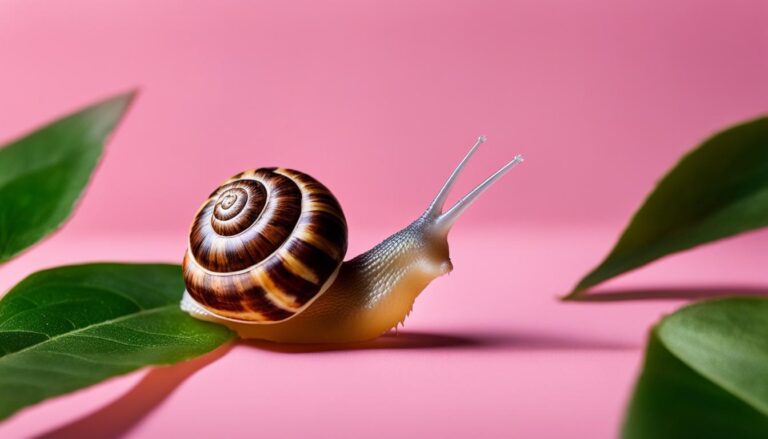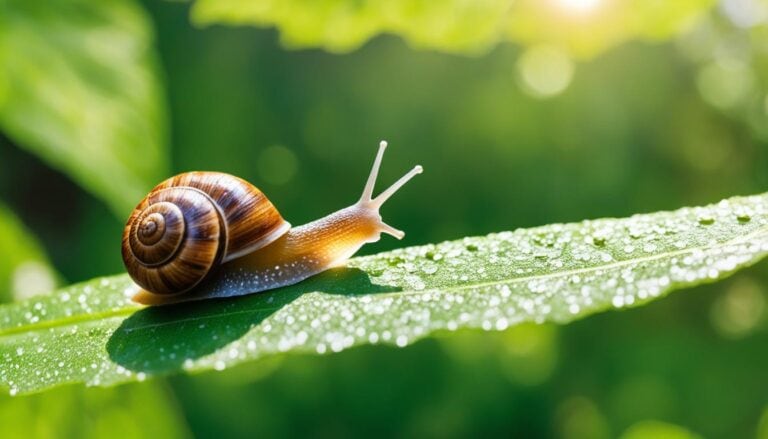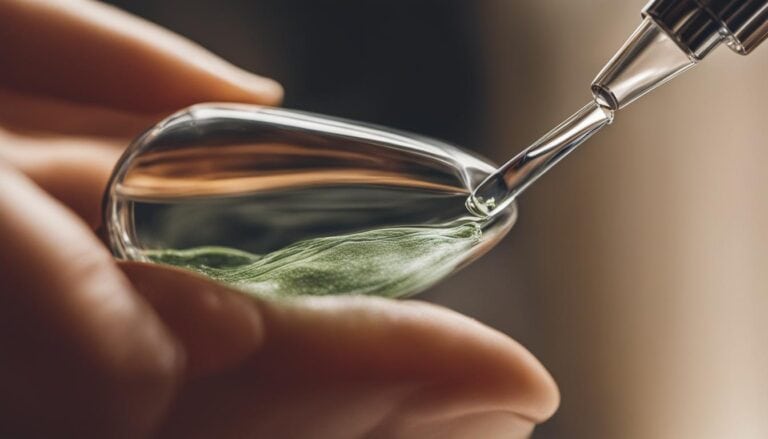Ethical and Sustainable Practices in Snail Mucin Harvesting
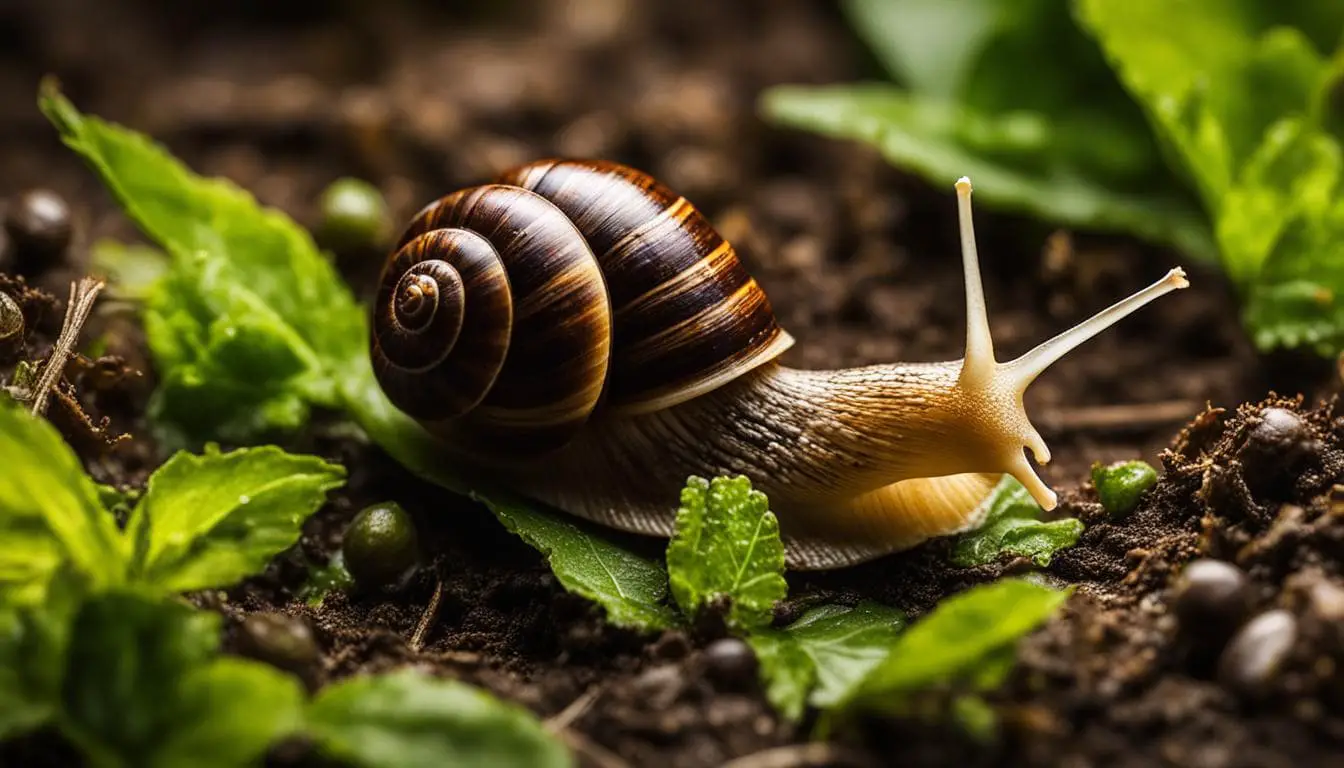
As you delve into the world of Eco-Friendly Skincare, the allure of snail mucin as a hydrating miracle draws attention not only for its skin-nourishing properties but also for the ethical snail mucin harvesting practices that it entails. With the growing consciousness around sustainable beauty practices, the need for responsible care and the use of cruelty-free skincare ingredients are at the forefront of the beauty industry’s modern ethos. By choosing products that honor this approach, you’re not only advocating for the welfare of these tiny creatures but also supporting the wider movement towards conscious consumerism in beauty and wellness. For a broader understanding of snail mucin, refer to our comprehensive guide on the subject.
The Increasing Popularity of Snail Mucin in Skincare
Imagine a skincare ingredient so potent that it beautifully intertwines hydration, healing, and, impressively, ethical sourcing. That ingredient is snail mucin—a substance capturing hearts with its skin-nourishing properties and ethical production story. Known for its capacity to lock in moisture, ease wrinkles, and visibly brighten hyperpigmentation, snail mucin has experienced a rapid rise to prominence in the skincare industry.
With an array of skincare marvels from soothing face masks to luxurious facials, the snail mucin-infused products have found a massive market across diverse segments of beauty consumers in the U.S. But what’s truly captivating is the narrative of snail mucin production ethics that’s appealing to the ethically-minded user.
“The assurance of environmentally friendly skincare coupled with the cutting-edge results of snail mucin has made it an irresistible choice for the conscious consumer.”
This surge goes beyond temporary trends. Rooted in the dining culture of various countries, particularly the culinary appetites of South Korea, snail mucin skyrocketed from a dietary delicacy to a cosmetic wonder, transforming farms into skincare goldmines. The transition not only increased output to match demand but did so by embedding sustainable snail mucin extraction processes, putting ethical beauty products at the center stage.
You might be pondering the scale of this phenomenon. Let’s sift through some compelling facts:
| Benefit | Description | Consumer Impact |
|---|---|---|
| Hydration | Snail mucin is known for its superior moisture-retention capabilities. | Products are in high demand for their ability to maintain skin plumpness and hydration. |
| Wrinkle and Scar Smoothing | The nutrients in snail mucin promote skin repair, smoothing fine lines and acne scars. | Increasing popularity among age-conscious consumers and those looking to repair skin texture. |
| Hyperpigmentation Improvement | Regular use of snail mucin can lead to a more even skin tone. | Users with uneven pigmentation are turning to snail mucin products for solutions. |
| Ethics in Production | Emphasis on non-harmful extraction methods. | Attracting ethical consumers seeking transparency and sustainability in their skincare. |
The appetite for ethical beauty products is more prominent than ever before. Indeed, as snail mucin secures its place in the limelight, it carries with it the promise of an ethical revolution in skincare—a revolution that beautifies not just the skin but the industry’s conscience.
Unveiling the History of Snail Mucin Use
Long before snail mucin became a buzzword in the realm of Ethical Skincare Ingredients, it found its roots in more humble beginnings. The story starts with local Chilean farmers, who discovered the skin-softening effects of snail mucin inadvertently while handling garden snails. This serendipitous find spurred the birth of a skincare cascade, with Elicina blazing the trail among the pioneering brands to harness this gift from nature.
The journey of snail mucin is well-embedded in history; the ancient Romans, connoisseurs of escargot, may not have realized they were setting an early precedent for an industry that would flourish in synergy between cuisine and cosmetics. It’s an intriguing thought, the idea that a gourmet preference could pave the way for Green Skincare Solutions, championing snail mucin and animal welfare centuries later in the US market.
As Elicina and other brands navigated their way into customers’ hearts and skincare regimens, the narrative around snail mucin grew to include more than just cosmetic benefits. It involved the wellbeing of the creatures providing this precious ingredient, with a spotlight on ethical harvesting practices.
The lingering question, however, has always been rooted deeply in the treatment of these creatures. The snail mucin and animal welfare relationship is undisputedly monumental, as the commercialization of these products would be meaningless without a solid ethical foundation. The dialogue surrounding ethical skincare ingredients has been enriched by the intersection of snail mucin’s culinary history and its burgeoning role in beauty — a fusion of gastronomy and aesthetics with a conscientious core.
Take a glimpse into the evolving ethos of brands catering to the informed, ethical consumer:
| Timeline | Development | Significance to Animal Welfare and Ethical Skincare |
|---|---|---|
| Mid-20th Century | Discovery by Chilean farmers | Accidental inception of snail mucin’s skincare utility |
| 1980s | Emergence of Elicina | Commercial use begun with attention to cultivation practices |
| Ancient Rome | Escargot consumption | Origins of cultivating snails in close quarters |
| Modern Day | Global skincare market expansion | Increased consumer awareness and demand for ethical production |
As we unwrap the layers of snail mucin’s past, it’s clear how intricately it has been woven into human history — with its modern tapestry reflecting a careful balance of tradition, innovation, and above all, ethical commitment to both skincare and animal welfare. This complex yet harmonious legacy is what positions snail mucin at the forefront of both ethical skincare ingredients and green skincare solutions.
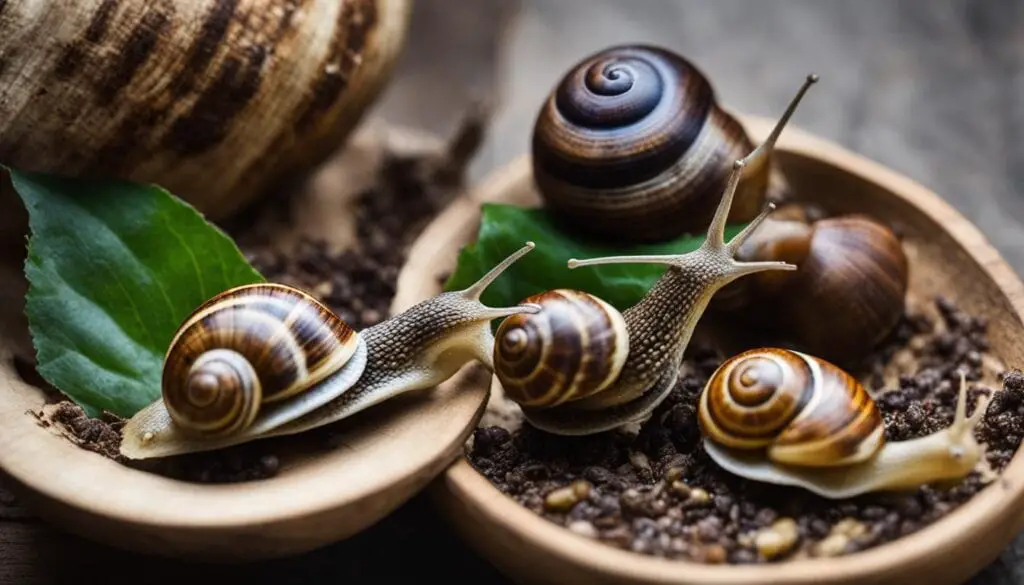
Understanding Snail Farming Sustainability
As you consider the transformative journey from a common garden creature to a revered skincare component, it’s essential to comprehend the foundations of snail farming sustainability. Heliciculture is central to this, offering insights into how snails are farmed for both culinary delights and the booming cosmetic industry. Let’s explore the fascinating world of sustainable snail farming and how it fosters a new era of ethical snail mucin harvesting.
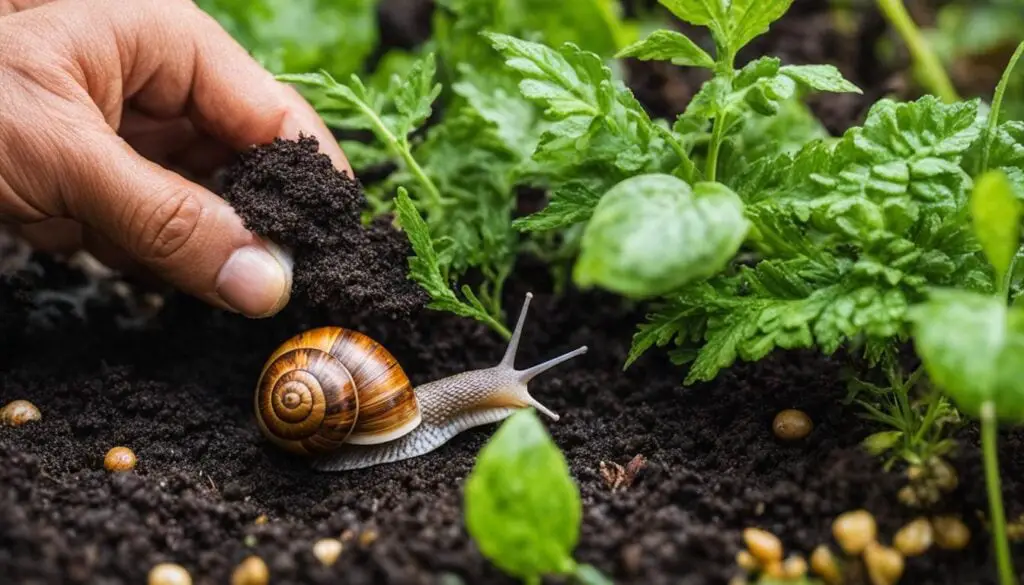
Heliciculture and the Global Snail Market
Heliciculture, the niche yet significant practice of snail farming, has long been associated with gastronomy, but its horizons have expanded. Supporting an estimated global market value of $1.2 billion signals not just a thriving industry but a testament to sustainable snail farming. The alignment with ethical principles is pivotal to ensuring that these small creatures are farmed responsibly, contributing to the growing demand while safeguarding their well-being.
Snail Mucin Production and Demand Growth
The rise in popularity of snail mucin for skin care is remarkable. Driven by its hydrating and rejuvenating properties, demand has escalated, provoking a considerable uptick in production. With this demand growth, snail farmers have adopted more responsible snail mucin collection techniques, ensuring that supply can meet demand without compromising ethical standards. This balance is crucial as the industry navigates the fine line between profitability and sustainability.
Transitioning from Culinary to Cosmetic Uses
Culinary traditions have serendipitously provided a stepping stone to cosmetic innovation. The shift from snail as a delicacy to a cornerstone of beauty regimens has been smooth, courtesy of the adaptability of farmers. Leveraging their expertise, practices have evolved to meet the burgeoning interest in snail mucin-infused products. Through ethical snail mucin harvesting, a cultural delicacy has transformed into a symbol of beauty and care, transcending borders and industries while aligning with sustainability goals.
Investigating Snail Mucin Extraction Processes
With the increased demand for Eco-Friendly Snail Mucin, understanding the snail mucin extraction processes becomes essential. Recognizing the difference between old and new techniques will inform your choices as a consumer committed to ethical snail mucin harvesting methods. It’s important to note that advancements have been made towards more sustainable snail mucin extraction, with a dedication to better practices.
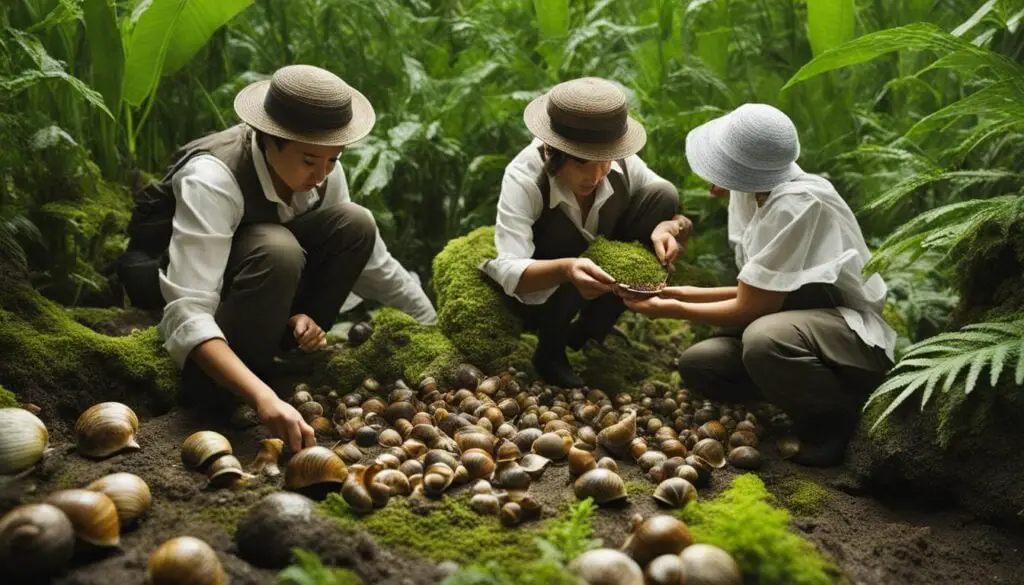
Old vs. New Extraction Techniques
In the past, snail mucin harvesting practices often fell short of the ethical standards we strive for today. Older methods of extraction were not always kind to the snails, sometimes involving immersion in substances that would harm and stress them. Today, newly developed methods such as the OzoSnail machine have revolutionized how mucin is collected, prioritizing the health and well-being of the snails throughout the process.
Industry Secrecy and Ethical Concerns
Companies have traditionally kept their snail mucin harvesting methods under wraps, which leads to questions regarding the ethical and humane treatment of the snails. This secrecy makes it difficult for consumers to assess the ethical nature of the products they are purchasing. The need for transparency is imperative to ensure that the production of snail mucin aligns with the consumer’s values of Ethical Snail Mucin Harvesting and supports their decision to contribute to a more sustainable snail mucin extraction industry.
Techniques That Protect Snail Welfare
Recent advancements in the industry have led to the development of extraction methods that are both effective and mindful of snail welfare. For instance, some eco-conscientious brands allow snails to roam on mesh surfaces in calm environments, facilitating the natural production of mucin without the snails experiencing harm or distress. It’s a move indicative of a broader trend towards ethical snail mucin harvesting methods that is gaining traction among informed consumers and setting a new standard in the skincare industry.
Examining the Different Species Used for Mucin Harvesting
When delving into the world of snail mucin species and their role in crafting ethical beauty products, it’s essential to distinguish which types are suitable for creating such skincare treasures. Not all snails are equal in the eyes of the beauty industry—some species produce mucin that’s highly beneficial for your skin, while others, if sourced incorrectly, might yield secretions that can be toxic. Knowledge of these species can guide you, the ethical consumer, towards sustainable snail mucin extraction options that contribute to an environmentally-friendly skincare routine.
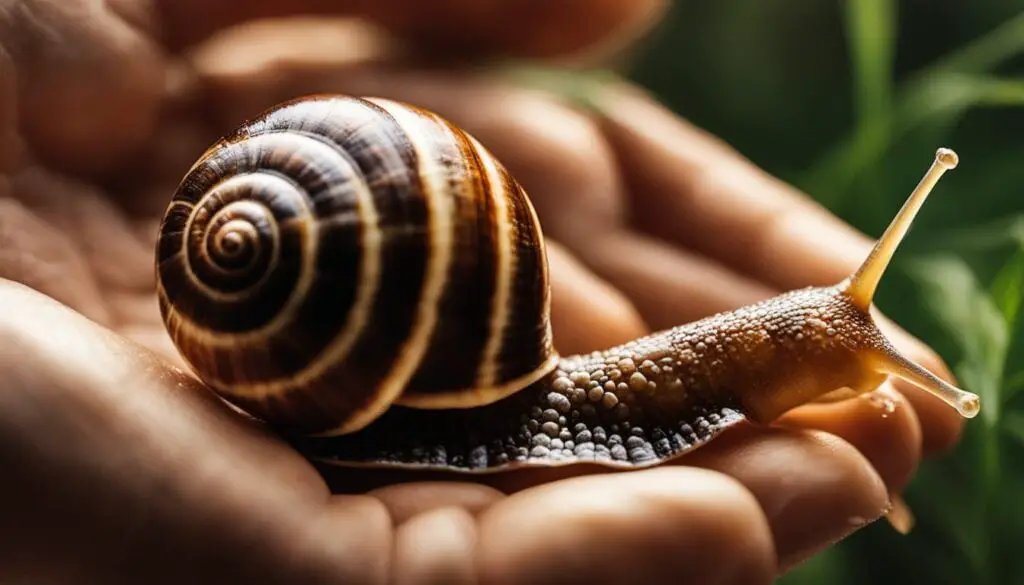
In practice, mucin is predominantly harvested from two preferable snail species. The Cornu aspersum, commonly known as the garden snail, and the Achatina fulica, or the giant African snail, have made a name for themselves in the cosmetic world. Understanding the differences between these species not only heightens our appreciation for snail mucin species but solidifies our commitment to ethical beauty products that don’t come at the expense of our slimy friends’ wellbeing.
| Species Name | Common Name | Beneficial Compounds in Mucin | Usability in Skincare |
|---|---|---|---|
| Cornu aspersum | Garden Snail | Collagen, Elastin, Allantoin | Highly suitable for hydrating and repairing products |
| Achatina fulica | Giant African Snail | Proteins, Glycolic Acid, Peptides | Preferred for anti-aging and texture-improvement products |
It’s not just about the type of snail but also how the mucin is obtained. Forward-thinking brands prioritize ethical beauty products by adopting sustainable snail mucin extraction techniques. This ensures that the skincare products you choose aren’t only effective but are also emblematic of responsible stewardship for our planet’s biodiversity. When you select a product infused with such considerately harvested ingredients, you’re casting a vote for a more environmentally friendly skincare future—one where beauty thrives in harmony with nature.
Challenges Facing Ethical Snail Mucin Harvesting
As the spotlight on Ethical Snail Mucin Harvesting intensifies, it illuminates the vital challenges within the industry. These challenges revolve around the imperative of ensuring dignified treatment of snails, bolstering consumer awareness, and navigating the evolving landscape of regulatory frameworks. Addressing these concerns is central to maintaining the integrity of Cruelty-Free Skincare Ingredients and preserving the essence of what makes a beauty product genuinely ethical.
Ensuring Snail Welfare during Extraction
Safeguarding the welfare of snails during mucin extraction is a cornerstone of ethical practices. The transition from ancient, rudimentary methods to modern, humane techniques signifies progress, but the journey doesn’t end here. Persistent efforts are required to continually elevate the standards of Responsible Snail Mucin Collection, ensuring that every creature is treated with the respect and care it deserves.
Consumer Awareness and Influence
Armed with knowledge and a set of discerning principles, you as a consumer possess the power to steer the market. By favoring brands committed to ethical practices, you amplify the demand for transparency and Responsible Snail Mucin Collection. Your choices echo a message loud and clear—only those companies that embrace Snail Mucin Production Ethics and furnish proof of their commitment will earn your trust and patronage.
Regulatory Implications and Certifications
The quest for ethical uniformity in the skincare industry may soon crystallize into formal regulations and certifications. A standardized benchmark for Ethical Snail Mucin Harvesting would enable consumers like you to navigate choices with confidence, assured by credible, third-party endorsements of a brand’s ethical manifesto. These certifications would serve as a beacon, guiding towards products that epitomize the highest ideals of Cruelty-Free Skincare Ingredients.
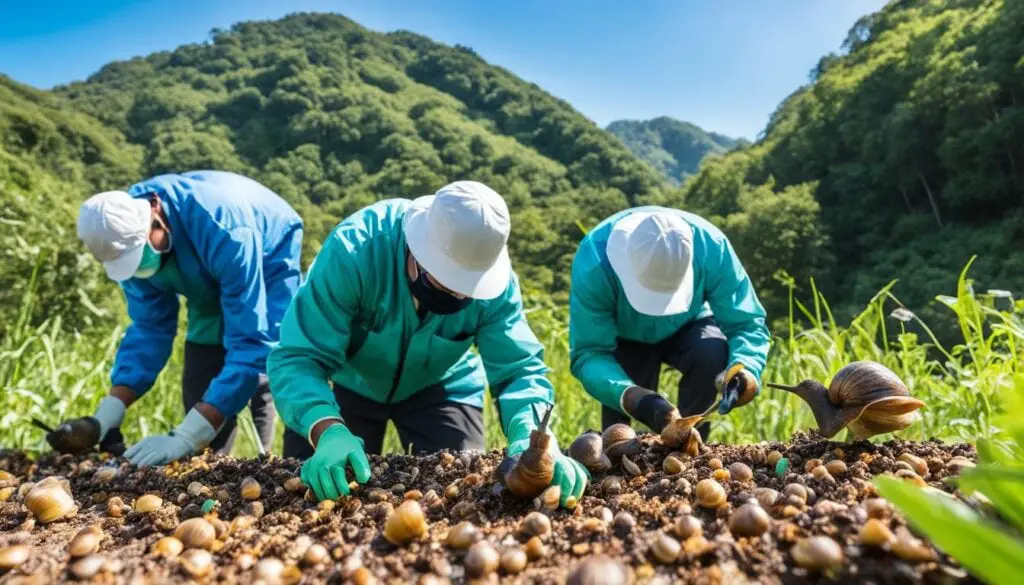
Cruelty-Free Skincare Ingredients: A Deeper Dive into Practices
In the pursuit of ethical beauty products, snail mucin has emerged as a linchpin for those committed to cruelty-free skincare ingredients. This key component can truly shine when its harvest respects the creatures behind the commodity. Seoul Ceuticals represents a paradigm of this dedication; their snails, treated as valued “pampered guests,” roam freely in controlled environments conducive to stress-free mucin production.
You may ask, how does this approach to ethical snail mucin harvesting affect the broader beauty industry? It reflects a shift in mindset toward empathetic and sustainable beauty practices, signaling a maturation that blends skincare efficacy with deep-set ethics. By understanding how ethically sourced ingredients like snail mucin can impact both skin health and animal welfare, you become part of a responsible consumer base that demands accountability and kindness.
These sustainable beauty practices aren’t just a fad; they’re the hallmarks of an industry that values life in all forms, promising a future where beauty isn’t borne from harshness.
While some brands remain guarded about the specifics of their mucin extraction processes, a commitment to transparency can strengthen trust and appeal among consumers like you, who care deeply about the origins of their skincare essentials. Here’s a closer look at what constitutes ethical snail mucin harvesting:
| Cruelty-Free Label | Extraction Method | Consumer Assurance |
|---|---|---|
| Seoul Ceuticals | Natural roaming on mesh surfaces | Snails are not harmed and can produce mucin stress-free |
| Modern Innovations | OzoSnail machine (Example only, not associated with Seoul Ceuticals) | Machine aids in collection without disturbing snail well-being |
Your role as a conscientious patron of the beauty industry has never been more influential. When you choose ethical skincare ingredients, your selections go beyond superficial benefits — they echo a collective call for compassion that resonates throughout the industry. The ongoing support for sustainable snail mucin extraction methods serves as a testament to the enduring power of principled consumer choices. It spurs on the evolution of ethical beauty products, propelling a movement that is both transformative and necessary for the welfare of all beings involved.
Adopting Eco-Friendly Snail Mucin Practices
The beauty industry stands at a critical juncture where environmentally friendly skincare converges with innovation to form eco-friendly snail mucin products. As a consumer, your awareness and demand for sustainable snail farming and extraction practices play an influential role in shaping this growing sector. Ethical harvesting resonates deeply with a vision for green skincare solutions that do not compromise ecosystem health.
The Role of Environmental Stewardship
In practicing environmental stewardship, those involved in the production of eco-friendly snail mucin must embrace methods that respect the land and the species they cultivate. This includes creating habitats that align with the snails’ natural conditions and implementing farming techniques that minimize environmental footprints. As you support brands that invest in such practices, you bolster the movement toward more sustainable snail farming and holistic beauty approaches.
Snail Mucin and Ecosystem Impact
While snail mucin is a potent ingredient for hydration and skin repair, its harvesting must be evaluated against its impact on ecosystems. Non-native snail species, for instance, introduce a host of considerations that require meticulous management to prevent unwanted ecological consequences. This is where the balance between ethical snail mucin harvesting and environmental conservation truly comes to light. Your choice to patronize brands that prioritize green skincare solutions contributes to a healthier planet and a more ethical beauty industry.
Responsible Snail Mucin Collection: Methods and Ethics
Exploring the essence of responsible snail mucin collection unravels a practice where the safety and well-being of snails are paramount. As the beauty industry tilts towards incorporating ethical skincare ingredients, it is essential to understand the intricacies involved in ethical snail mucin harvesting. This humane approach not only signifies respect for living creatures but also aligns with the values of modern consumers who demand cruelty-free skincare ingredients.
Let us delve into the methods that embody the very principles of kindness in skincare production:
- Humane Extraction Techniques: Innovative and non-invasive methods have been developed to collect snail mucin without causing harm or distress to the snails. These ensure that the mucin is only gathered once the snails have naturally produced and left it behind, paralleling the process of harvesting fruits without harming the tree.
- Environmental Enrichment: The environment in which snails are reared directly impacts the quality of the mucin produced. By mimicking their natural habitats and providing enriched conditions, snails can thrive and produce mucin more effectively.
- Post-Extraction Care: The duty of an ethical producer does not end with mucin collection. Ensuring that snails have adequate time to rest and regenerate post extraction is critical to maintaining a sustainable practice.
It’s telling that the move towards cruelty-free is not just a marketing trend but a reflection of deeper societal shifts towards ethical consumption. Your choice to support brands that engage in ethical snail mucin harvesting has profound implications, not just for the beauty industry but for biodiversity and our collective moral compass.
“Responsible snail mucin collection is more than a process; it’s a commitment to ethical stewardship that values the harmony between nature and the pursuit of beauty.”
Moreover, the transparency of these brands in sharing their collection methods builds trust and offers you the assurance that the skincare products you use are responsibly sourced. It’s this clarity in communication coupled with the integrity of practices that positions certain skincare brands as leaders in ethical skincare ingredients.
As you navigate the beauty aisles, your awareness and decisions have the power to support sustainable practices and contribute to a more ethical future. Remember, your skin’s health and beauty can flourish alongside ethical standards that respect both snails and the environment, thanks to the pioneering efforts in responsible snail mucin collection.
Snail Farming Sustainability: Balancing Demand and Welfare
The emergence and sustained interest in snail farming sustainability highlight a collective push towards sustainable snail farming techniques that consider both the skyrocketing demand and the need for responsible snail mucin collection. In the crossroads between cultural culinary practices and innovative skincare solutions lies the ethical responsibility to maintain and enhance the welfare of these mollusks.
Italian innovations in the realm of snail mucin extraction, for instance, showcase how demand can coexist with compassion. Cutting-edge techniques have been devised to collect mucin in a way that ensures the snails’ welfare isn’t compromised. These advancements signify a commitment to ethical snail mucin harvesting and are crucial in supporting the cultivation of snail mucin for diverse industries without ethical trade-offs.
Responsible snail farming encompasses more than rearing snails for economic gain; it signifies a stewardship over their well-being and a pledge to the principles of ethical harvesting.
It is this harmony of ethics and demand that has cemented snail farming sustainability as a practice that respects life and aligns with the values of increasingly conscientious consumers. As the market for snail-derived products continues to grow, reaffirming these ethical tenets becomes not just a choice but a necessity for the future of the industry.
| Aspect of Sustainability | Practice | Impact on Snail Welfare | Benefits to Industry |
|---|---|---|---|
| Feed and Habitat | Organic and natural diet; simulated natural habitats | Healthier snails capable of producing high-quality mucin | Enhanced brand reputation for ethical sourcing |
| Mucin Extraction | Gentle and non-invasive techniques | Minimal stress and potential harm to snails | Sustainable supply of mucin for cosmetics and culinary use |
| Post-Extraction Care | Ample recovery time and conditions for snails | Ability of snails to regenerate and produce mucin again | Reduced mortality rates and increased efficiency |
By bringing to light the essence of ethical snail mucin harvesting, you become an empowered participant in guiding the industry towards practices that reflect reverence for life. Your decisions and support for brands that adhere to these practices play an instrumental role in cultivating a responsibly harvested, ethically conscious future for skincare and beyond.
Pioneering Ethical Beauty Products with Snail Mucin
As the green wave continues to rise, the beauty industry is witnessing a paradigm shift towards ethical beauty products with a spotlight on transparent ingredient sourcing. Central to this movement is snail mucin – a heralded ingredient in the arsenal of sustainable and responsible skincare.
Evaluating the Ethical Promise of Beauty Brands
In an era where ethical skincare ingredients are valued more than ever, discerning consumers like yourself are paying close attention to the promises made by beauty brands. You demand evidence that companies not only talk the talk but also walk the walk when it comes to their ethical claims.
Brands that are upfront about their processes and the provenance of their ingredients, especially snail mucin, are finding a warm reception in the marketplace. You, as eco-conscious consumers, reward such transparency by choosing brands that furnish clear information about how their products are made and how they impact both society and the environment.
Transparency in Ingredient Sourcing
Brands with a commitment to transparent ingredient sourcing stand in stark contrast to those shrouded in secrecy. Visibility into the supply chain, right down to how snail mucin is collected, becomes a critical factor in your purchasing decision. Complete transparency has become the new currency of trust in a market flush with choices.
| Brand Component | Impact on Consumer Trust | Relation to Sustainable Practices |
|---|---|---|
| Purity of Sources | Increases due to confidence in ingredient safety and ethics | Reflects commitment to environmental stewardship |
| Harvesting Methods | Strengthens when non-invasive techniques are employed | Signals respect for animal welfare and long-term viability |
| Partnership Transparency | Enhances with the disclosure of ethical collaborations | Indicates a broader impact on sustainable beauty practices |
The embrace of sustainable beauty practices has encouraged leading industry players to reevaluate and redesign their business models. By fostering an ethos predicated on responsibly-sourced ingredients and ethical production, brands not only align with your values but also set a benchmark for others to follow, driving the industry towards a future compatible with the planet’s health and communal well-being.
The Relationship Between Snail Mucin and Animal Welfare
As you explore the skincare ingredient landscape, the bond between Snail Mucin and Animal Welfare becomes increasingly apparent. The industry’s pivot towards ethical snail mucin harvesting mirrors a broader commitment to cruelty-free practices and sustainable beauty solutions. Brands that prioritize the humane treatment of snails not only secure a high-quality mucin but also reinforce their ethical standing in the beauty market, appealing to your conscience as a compassionate consumer.
The methodology behind ethical snail mucin harvesting plays a pivotal role in aligning skincare with animal welfare principles. Innovations in extraction technology, such as gentle machinery and stress-free environments, ensure the snails’ well-being is placed at the heart of mucin production. Brands adopting these humane extraction methods contribute to the sector’s robust growth, all while maintaining a standard that resonates with your values. When you select products with cruelty-free skincare ingredients, you’re actively choosing a path that values life in all its forms.
Moreover, the integrity of sustainable snail mucin extraction practices has a rippling effect across the industry, signaling to consumers that ethical production is not only possible but paramount. By voicing your preference for brands that place animal welfare at the forefront, you have the power to influence industry norms and inspire other companies to adopt similar sustainable measures. This collective action steers the beauty industry toward more compassionate practices, safeguarding animal welfare while nurturing your skin with the promise of purity and care.
FAQ
What is ethical snail mucin harvesting?
Ethical snail mucin harvesting pertains to methods that collect snail mucin without causing harm or stress to the snails. It involves ensuring a safe and comfortable environment for the snails, sometimes allowing them to roam on mesh nets where mucin is gathered after they move. Practices that prioritize the well-being of the snails align with the standards of ethical snail mucin harvesting.
Why has snail mucin become popular in skincare?
Snail mucin has gained popularity due to its hydrating and regenerative properties, which are beneficial for the skin. These include promoting collagen production, reducing wrinkles, and healing scars. Its rise in popularity is also due to the influence of K-beauty trends and increasing consumer interest in natural and ethical skincare ingredients.
What historical use of snail mucin is known in skincare?
The use of snail mucin in skincare dates back to ancient times. Chilean farmers noted the softness of their hands after handling snails, which led to its use in skincare products. Additionally, there are accounts of ancient Romans using products derived from snails, pointing to a long-standing tradition of snail mucin in skincare.
How does snail mucin harvesting impact snail welfare?
Improper snail mucin harvesting methods can lead to stress and physical harm to snails. Ethical harvesting practices ensure that mucin is collected in a way that does not distress or injure the snails. By providing humane conditions and gentle mucin extraction procedures, the welfare of snails is respected and sustained.
What are the differences between old and new snail mucin extraction techniques?
Old extraction techniques often involved immersing snails in salt water or vinegar, which hurt and stressed the snails. Newer techniques, such as stress-free environments where snails naturally produce mucin, are more humane and sustainable, aligning with ethical harvesting practices.
Are there different species of snails used for mucin harvesting?
Yes, there are different species of snails used for mucin harvesting, mainly based on their safety and efficacy for human skincare. The garden snail (Cornu aspersum) and the giant African snail (Achatina fulica) are among the most commonly used species in cosmetic products.
How can consumers influence ethical snail mucin harvesting?
Consumers can influence ethical snail mucin harvesting by supporting brands that are transparent about their cruelty-free and eco-friendly harvesting practices. Choosing products from companies committed to ethical standards encourages the industry to adopt responsible and sustainable practices.
What do cruelty-free skincare ingredients mean concerning snail mucin?
Cruelty-free skincare ingredients, including snail mucin, mean that no animals were harmed or subjected to cruelty during the sourcing and production process. These products are obtained in a manner that ensures the welfare and humane treatment of the snails whose mucin is being harvested.
What is the importance of environmental stewardship in snail mucin harvesting?
Environmental stewardship in snail mucin harvesting is crucial to prevent negative impacts on local ecosystems, such as the introduction of invasive snail species. Sustainable practices ensure that the environment is protected and that the harvesting processes are in harmony with nature.
How do ethical beauty brands source snail mucin?
Ethical beauty brands source snail mucin by engaging with farms that prioritize snail welfare and adhere to strict cruelty-free and eco-friendly standards. These brands often provide transparency about their sourcing methods and ensure that ethical practices are followed in every step of mucin collection.
Can the snail mucin industry be both sustainable and meet high demand?
Yes, the snail mucin industry can be sustainable while meeting high demand by using responsible farming practices, technological advancements in extraction methods, and a commitment to the well-being of snails. Balancing commercial interests with animal welfare is key to sustaining a cruelty-free snail mucin production.

